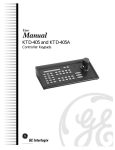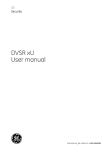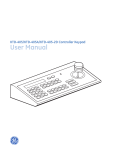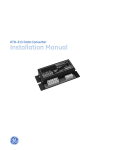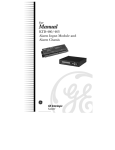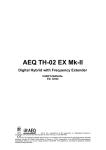Download User Manual - Interlogix
Transcript
KTD-400 Controller Keypad User Manual KTD-400 GE Security Copyright Copyright © 2006, GE Security Inc. All rights reserved. This document may not be copied or otherwise reproduced, in whole or in part, except as specifically permitted under US and international copyright law, without the prior written consent from GE. Document number/ 1034790E (March 2006). Disclaimer THE INFORMATION IN THIS DOCUMENT IS SUBJECT TO CHANGE WITHOUT NOTICE. GE ASSUMES NO RESPONSIBILITY FOR INACCURACIES OR OMISSIONS AND SPECIFICALLY DISCLAIMS ANY LIABILITIES, LOSSES, OR RISKS, PERSONAL OR OTHERWISE, INCURRED AS A CONSEQUENCE, DIRECTLY OR INDIRECTLY, OF THE USE OR APPLICATION OF ANY OF THE CONTENTS OF THIS DOCUMENT. FOR THE LATEST DOCUMENTATION, CONTACT YOUR LOCAL SUPPLIER OR VISIT US ONLINE AT WWW.GESECURITY.COM. This publication may contain examples of screen captures and reports used in daily operations. Examples may include fictitious names of individuals and companies. Any similarity to names and addresses of actual businesses or persons is entirely coincidental. Trademarks and patents GE and the GE monogram are registered trademarks of General Electric. Other trade names used in this document may be trademarks or registered trademarks of the manufacturers or vendors of the respective products. Intended use Use this product only for the purpose it was designed for; refer to the data sheet and user documentation. For the latest product information, contact your local supplier or visit us online at www.gesecurity.com. FCC compliance This equipment has been tested and found to comply with the limits for a Class A digital device, pursuant to part 15 of the FCC Rules. These limits are designed to provide reasonable protection against harmful interference when the equipment is operated in a commercial environment. This equipment generates, uses, and can radiate radio frequency energy and, if not installed and used in accordance with the instruction manual, may cause harmful interference to radio communications. You are cautioned that any changes or modifications not expressly approved by the party responsible for compliance could void the user's authority to operate the equipment. iii Contents Preface . . . . . . . . . . . . . . . . . . . . . . . . . . . . . . . . . . . . . . . . . . . . . . . . . . . . . . . . . . . . . . . . . . . . . . . . . . . . . 1 Conventions used in this document. . . . . . . . . . . . . . . . . . . . . . . . . . . . . . . . . . . . . . . . . . . . . . . . . . . . . . . . . . . . . . . . . . . . . . . .1 Safety terms and symbols . . . . . . . . . . . . . . . . . . . . . . . . . . . . . . . . . . . . . . . . . . . . . . . . . . . . . . . . . . . . . . . . . . . . . . . . . . . . . . . .1 Product overview . . . . . . . . . . . . . . . . . . . . . . . . . . . . . . . . . . . . . . . . . . . . . . . . . . . . . . . . . . . . . . . . . . . . 2 Controller keypad placement . . . . . . . . . . . . . . . . . . . . . . . . . . . . . . . . . . . . . . . . . . . . . . . . . . . . . . . . . . . . . . . . . . . . . . . . . . . . .2 Installation . . . . . . . . . . . . . . . . . . . . . . . . . . . . . . . . . . . . . . . . . . . . . . . . . . . . . . . . . . . . . . . . . . . . . . . . . 3 DIP switch settings . . . . . . . . . . . . . . . . . . . . . . . . . . . . . . . . . . . . . . . . . . . . . . . . . . . . . . . . . . . . . . . . . . . . . . . . . . . . . . . . . . . . . . .3 Mounting the KTD-300R. . . . . . . . . . . . . . . . . . . . . . . . . . . . . . . . . . . . . . . . . . . . . . . . . . . . . . . . . . . . . . . . . . . . . . . . . . . . . . . . . . .4 Wiring connections . . . . . . . . . . . . . . . . . . . . . . . . . . . . . . . . . . . . . . . . . . . . . . . . . . . . . . . . . . . . . . . . . . . . . . . . . . . . . . . . . . . . . . .4 Power-up . . . . . . . . . . . . . . . . . . . . . . . . . . . . . . . . . . . . . . . . . . . . . . . . . . . . . . . . . . . . . . . . . . . . . . . . . . . . . . . . . . . . . . . . . . . . . . . .5 KTD-400 configuration . . . . . . . . . . . . . . . . . . . . . . . . . . . . . . . . . . . . . . . . . . . . . . . . . . . . . . . . . . . . . . . 6 System component configuration . . . . . . . . . . . . . . . . . . . . . . . . . . . . . . . . . . . . . . . . . . . . . . . . . . . . 10 PTZ receiver configuration . . . . . . . . . . . . . . . . . . . . . . . . . . . . . . . . . . . . . . . . . . . . . . . . . . . . . . . . . . . . . . . . . . . . . . . . . . . . . . 11 Operation. . . . . . . . . . . . . . . . . . . . . . . . . . . . . . . . . . . . . . . . . . . . . . . . . . . . . . . . . . . . . . . . . . . . . . . . . . 14 Key layouts . . . . . . . . . . . . . . . . . . . . . . . . . . . . . . . . . . . . . . . . . . . . . . . . . . . . . . . . . . . . . . . . . . . . . . . . . . . . . . . . . . . . . . . . . . . . 14 Key functions . . . . . . . . . . . . . . . . . . . . . . . . . . . . . . . . . . . . . . . . . . . . . . . . . . . . . . . . . . . . . . . . . . . . . . . . . . . . . . . . . . . . . . . . . . 15 Keypad operation . . . . . . . . . . . . . . . . . . . . . . . . . . . . . . . . . . . . . . . . . . . . . . . . . . . . . . . . . . . . . . . . . . . . . . . . . . . . . . . . . . . . . . 17 Multiplexer operation . . . . . . . . . . . . . . . . . . . . . . . . . . . . . . . . . . . . . . . . . . . . . . . . . . . . . . . . . . . . . . . . . . . . . . . . . . . . . . . . . . . 19 VCR operation . . . . . . . . . . . . . . . . . . . . . . . . . . . . . . . . . . . . . . . . . . . . . . . . . . . . . . . . . . . . . . . . . . . . . . . . . . . . . . . . . . . . . . . . . . 20 Contacting technical support . . . . . . . . . . . . . . . . . . . . . . . . . . . . . . . . . . . . . . . . . . . . . . . . . . . . . . . . 21 Online publication library . . . . . . . . . . . . . . . . . . . . . . . . . . . . . . . . . . . . . . . . . . . . . . . . . . . . . . . . . . . . . . . . . . . . . . . . . . . . . . . 21 Index . . . . . . . . . . . . . . . . . . . . . . . . . . . . . . . . . . . . . . . . . . . . . . . . . . . . . . . . . . . . . . . . . . . . . . . . . . . . . . 23 iv KTD-400 Controller Keypad User Manual 1 Preface This is the GE KTD-400 Controller Keypad User Manual for models KTD-400 and KTD-300R. This document includes an overview of the product and detailed instructions explaining: • • how to install and program; and how to operate the KTD-400 and KTD-300R. There is also information describing how to contact technical support if you have questions or concerns. To use this document effectively, you should have the following minimum qualifications: • • a basic knowledge of CCTV systems and components; and a basic knowledge of electrical wiring and low-voltage electrical connections. Read these instructions and all ancillary documentation entirely before installing or operating this product. The most current versions of this and related documentation may be found on our website. Refer to Online publication library on page 21 for instructions on accessing our online publication library. Note: A qualified service person, complying with all applicable codes, should perform all required hardware installation. Conventions used in this document The following conventions are used in this document: Bold Menu items and buttons. Italic Emphasis of an instruction or point; special terms. File names, path names, windows, panes, tabs, fields, variables, and other GUI elements. Titles of books and various documents. Blue italic (Electronic version.) Hyperlinks to cross-references, related topics, and URL addresses. Monospace Text that displays on the computer screen. Programming or coding sequences. Safety terms and symbols These terms may appear in this manual: CAUTION: Cautions identify conditions or practices that may result in damage to the equipment or other property. WARNING: Warnings identify conditions or practices that could result in equipment damage or serious personal injury. 2 KTD-400 Controller Keypad User Manual Product overview The KTD-400 Controller Keypad is designed for use in a Digiplex system. The KTD-400 can address and control 512 pan/tilt/zoom (PTZ) receiver sites, operate a matrix switcher with 64 monitor outputs, and address/ select views from as many as 64 multiplexers and VCRs. Several modes of multiplexers are supported. Note: For CyberDome control with the KTD-400, pan/tilt operation is limited to three speeds. To operate and control multiplexers and VCRs, you must have a KTD-93 auxiliary device driver attached to each device in a Digiplex system. Controller keypad placement A Digiplex system’s RS-422 control signal originates from the controller keypad located at the head of the system and travels down line via twisted-pair cable. When more than one controller keypad is used, the signal must loop through each keypad (Figure 1) or be merged using KTD-312 signal mergers (Figure 2) before being routed to the rest of the components in the system. Figure 1. Placement in a Digiplex system RS-422 Multiplexer KTD-93 Video switcher Keypad RX Keypad Figure 2. Placement using a KTD-312 signal merger KTD-312 RS-422 Multiplexer KTD-93 Video switcher Keypad Keypad RX 3 Installation To install a KTD-400 keypad, you will need to set the DIP switches, mount the unit (KTD-300R only), and wire the device. CAUTION: Do not connect power to the unit before all installation steps have been completed. Do not connect directly to a telecommunication network. DIP switch settings Use Table 1 to select your mode of operation. Table 1. DIP switch settings Setting Binary Description 1000 Digiplex PTZ and VCR control only. 0100 Controlling a robot MV96 multiplexer with a KTD-93. 1100 Digiplex PTZ, multiplexer, and VCR control (factory setting). 0000 Controlling a robot MV96 multiplexer with a KTD-93. Figure 3 shows how to open the KTD-400 and KTD-300R and locate the DIP switches. Figure 3. DIP switch locations for KTD-400 and KTD-300R models 4-position DIP switch KTD-400 KTD-300R 4 KTD-400 Controller Keypad User Manual Mounting the KTD-300R The KTD-300R is designed to fit into a standard EIA 19-inch rack and uses one unit (1.75 in.) of rack space. Mount the unit using the four holes in its front panel and hardware provided from the rack manufacturer. Wiring connections The KTD-400 comes with a 6 ft. (1.8 m) cable that attaches to a modular phone box (Figure 4). All external connections are made in the phone box. KTD-300R connections are made to the removable terminal strip located on the back of the unit (Figure 5 on page 4). Wiring the KTD-400 and 300R to control a standard Digiplex system involves connecting the RS-422 input cable (if used), the RS-422 output cable, and the 12 VDC wall transformer. Note: Figure 4, Figure 5, and Figure 6 on page 5 show connection points for an RS-422 input cable and an RS-422 output cable. Do not confuse the two. The input is used only if other keypads, alarm chassis, or time/date generators are located ahead of the unit that is being wired. Figure 4. KTD-400 modular phone box connections for standard Digiplex control 12 VDC wall transformer RS-422 control signal in RS-422 control signal out Color code Y = Yellow G = Green BR = Brown WH = White R = Red BL = Black O = Orange B = Blue Modular phone box Keypad Figure 5. KTD-300R terminal strip connections for standard Digiplex control KTD-300R keypad Terminal strip RS-422 control signal in RS-422 control signal out 12 VDC wall transformer 5 KTS-41 system control Wiring the KTD-300R to control a KTS-41A system involves connecting the RS-422 input cable (if used), the RS-422 output cable (if used), the DTMF output cable (to the KTS-41A), and the 12 VDC wall transformer (Figure 6). Figure 6. KTD-300R connections with KTS-41A control KTD-300R keypad Terminal strip 12 VDC wall transformer RS-422 control signal in RS-422 control signal out DTMF to KTS-41A Power-up After you make all the connections, the KTD-400 or KTD-300R will be ready for operation. Plug the 12 VDC wall transformer into a power outlet. The LCD window will briefly display keypad setting information (Figure 7 on page 6), then it will enter the operating mode. 6 KTD-400 Controller Keypad User Manual KTD-400 configuration After you install and power up your KTD-400 keypad, you will need to configure it to operate within your systems. You can also use the KTD-400 to configure other components in the Digiplex system. (See System component configuration on page 10.) The KTD-400 offers many programming choices that identify how it will function in the system. A separate code is used to access the menus. For new installations, follow the programming steps in the order they are presented. If you need to change any programmed data at a later date, enter the appropriate programming mode and use the designated keys to advance the menu associated with that data. • • • • • • • • System size (see Figure 11 on page 7) Camera site access (see Figure 12 on page 7) Monitor access (see Figure 13 on page 8) Multiplexer enable and select (see Figure 14 on page 8) Multiplexer view display (see Figure 15 on page 8) VCR enabled (see Figure 16 on page 9) Maximum presets (see Figure 17 on page 9) Monitor offset (see Figure 18 on page 9) When you supply power to the unit, the LCD will momentarily display a limited amount of configuration information on the unit (Figure 7). Figure 7. Programming display KTD-400 255 64 64 DDMMYY 00 0 64 Largest Largest Largest Largest camera monitor multiplexer VCR Monitor offset Revision number Key layout After a few seconds, the normal operating display menu (Figure 8 on page 6) will appear. To configure the KTD-400, do the following:. 1. In the normal operating display (Figure 8), enter programming mode by pressing and holding the Set key until you see the display in Figure 9. 2. At the code entry display (Figure 9), enter the access code 5, 7, 9, Seq. Figure 8. Normal operating display CAMERA 000 MONITOR 01 Figure 9. Code entry display CAMERA 000 MONITOR 01 (CODE) (----) 7 3. The clear memory option (Figure 10) will erase all data in the controller keypad’s nonvolatile memory and reload the factory default values. • • If you do not want to clear the memory, press 0. This will advance you to the system size display (Figure 11). To clear the controller keypad’s memory, press 1. This will advance you to the confirmation display. Press 3 to reload the controller keypad’s memory with factory default values. If you do not want to clear the memory, press 0. This will advance you to the system size display (Figure 11). 4. At the system size display (Figure 11), use the numerical keys to enter the largest camera number (maximum 511), largest monitor number (maximum 64), largest multiplexer number (maximum 64), and largest VCR number (maximum 64) in the system. Use the left and right arrow keys to switch between columns. Once you have made all entries, the display will advance to the next menu. Note: CLEAR MEMORY? 0=NO 1=YES SEQ=EXIT ARE YOU SURE? 0=NO 3=YES SEQ=EXIT Figure 11. System size display SYST SIZE (CAMERAS) 511 64 64 64 SEQ=NEXT Multiplexer and VCR entries can be 00, which means there are no units in the system (display will skip subsequent menus). 5. The camera site access display (Figure 12) lets you deny or permit the controller keypad access to certain camera sites. Press 0 to deny access or 1 to permit access. After each selection, the next camera number will appear. Use the up and down arrow keys to move between cameras. When done, press Seq to advance to the next menu. Note: Figure 10. Clear memory display In steps 6 through 8, Seq will not advance to the next menu if you deny access to all cameras, monitors, and VCRs. At least one camera site, monitor, multiplexer, or VCR must have access. Figure 12. Camera site access display CAMERA 000 0=NO 1=YES ACC=YES SEQ=NEXT 8 KTD-400 Controller Keypad User Manual 6. Use the menu in Figure 13 to deny or permit the controller keypad’s access to certain monitors. Press 0 to deny access or 1 to permit access. After each selection, the next monitor number will appear. Use the up and down directional arrows to move between monitors. When done, press Seq to advance to the next menu. 7. The menus in Figure 14 let you select which multiplexers can be enabled from the keypad. The first display will only come up if your system has at least one multiplexer. • • • If you don’t want to enable any multiplexers, press Seq to advance to the VCR access menu (Figure 16 on page 9). Press 0 to advance to the next multiplexer, or use the up and down arrows to move between multiplexers. Press 1 to enable a multiplexer. This will advance you to the multiplexer select display. Use the up and down arrows to scroll through the alphabetical list of models. After selecting a multiplexer, press Seq to advance to the next menu. 8. The multiplexer view display (Figure 15) determines which views will be enabled when the keypad is in multiplexer operating mode. (In multiplexer operating mode, pressing View toggles through the views.) Some multiplexer models do not have selectable views and will skip this menu. Use the down key to scroll through the list of views available. For each view, press 1 to accept or 0 to decline. After you have selected all views, press Seq to return to the multiplexer enabled menu display (Figure 14). Figure 13. Monitor access display MONITOR 01 0=NO 1=YES ACC=YES SEQ=NEXT Figure 14. Multiplexer access menus MPLXR 01 0=NO 1=YES ACC=NO SEQ=NEXT MPLX 01: SELECT(LK) ATV SEQ=NEXT Figure 15. Multiplexer view display VIEW: PIP 0=NO 1=YES L=NXT YES SEQ=EX 9 9. The menu in Figure 16 lets you select which VCRs can be can be enabled from the keypad. This display will only come up if your system has at least one VCR. • • • Figure 16. VCR access display VCR 01 ACC=YES 0=NO 1=YES SEQ=NEXT If you don’t want to enable any VCRs, press Seq to advance to the maximum preset display (Figure 17). Press 0 to advance to the next VCR, or use the up and down arrows to move between VCRs. Press 1 to enable a VCR. After setting values for all VCRs in your system, press Seq to advance to the next menu. 10. The menu in Figure 17 determines the maximum number of programmable presets that can be accessed from the keypad. The range is from 00 (none) to 63. Press Seq to advance to the next menu. 11. The default program for the keypad indicates that the selected monitor number will correspond to the number of the matrix switcher output to which it is connected. For example, if monitor 12 appears in the keypad’s display window and a camera selection is made, the monitor that is connected to output 12 of the matrix switcher will switch to that camera. Figure 17. Maximum preset display MAX PRESET: 09 (OO FOR NONE) SEQ=NEXT Figure 18. Monitor offset display MONITOR OFFSET NUMBER? SEQ=NEXT In some applications, you may prefer to number the monitors 1, 2, 3, etc., instead of using the matrix switcher output number. To allow for the difference in numbers, subtract the desired monitor number from the matrix switch output number and enter the result as the monitor offset in the menu shown in Figure 18. For example, if a keypad has a monitor that is connected to matrix switcher output 8, to enable the monitor to be addressed as monitor 1, subtract 1 from 8 and enter 7 as the monitor offset. 8 (matrix switcher number) - 1 (monitor number) = 7 (offset) In this example, if more than one monitor were to be controlled from the keypad, additional monitors would be connected to matrix switcher outputs 9, 10, 11, etc. and would be controlled as monitors 2, 3, 4, etc. Note: The keypad will deny any monitor offset number that conflicts with the largest monitor (Figure 11 on page 7) and monitor access (Figure 13 on page 8) programming choices that you made earlier in this section. After you make an entry in the monitor offset display, the keypad will return to the normal operating display. 10 KTD-400 Controller Keypad User Manual System component configuration After you have completed the KTD-400 keypad configuration, you can used the keypad to configure other Digiplex system components. To configure these system components, begin at the normal operating display and do the following: 1. In the normal operating display shown in Figure 19, press and hold the Set key until the display in Figure 20 appears. 2. In the menu in Figure 20, enter the access code 9, 5, 1, Seq. The next display will appear. 3. The component programming selection menu (Figure 21) lets you select which component (video switchers, PTZ receivers, alarm interfaces, and CyberDomes) to program. Figure 19. Normal operating display CAMERA 000 MONITOR 01 Figure 20. Code entry display CAMERA 000 MONITOR 01 (CODE) (----) Figure 21. Component configuration selection display 1=SWTCH 4=CYBER 2=PTZ 3=ALRM SEQ=EXIT To configure video switchers, alarm interfaces, and CyberDomes, press the appropriate number at the component configuration selection menu (Figure 21) and refer to the programming instructions provided with those products. To configure PTZ receivers, press 2 at the component configuration selection display (Figure 21) and follow the instructions in PTZ receiver configuration on page 11. 11 PTZ receiver configuration Each PTZ receiver offers modes of operation choices, many of which can be programmed using a KTD-400 series keypad. It can also store preset position information if applicable. To program a PTZ receiver, complete the steps in System component configuration on page 10, press 2 at the component programming selection menu (Figure 21 on page 10), then do the following (for all cameras): 1. At the receiver site selection display (Figure 22), use the numerical keys to enter the receiver site to be programmed. The next display will appear. 2. At the receiver setup display (Figure 23), press 1 to begin receiver setup. The display will automatically advance to the first setup menu. (Pressing 2 allows you to set the PTZ’s presets. See PTZ receiver preset position programming on page 13.) 3. If you want the pan/tilt receiver to autopan, enter one of the following choices in Figure 24: 0 = Disables the autopan function. Figure 22. Receiver site selection display ENTER RECEIVER SITE NUMBER 00 SEQ=NEXT Figure 23. Receiver setup display 1=SETUP 2=PRESETS SEQ=NEXT Figure 24. Pan cycle display PAN CYCL? 0=0% 2=100% 3=RDM 1=50% SEQ=NEXT 1 = Assigns a 50% duty cycle when the receiver is in autopan mode (unit alternately pans and rests for 8 second intervals). 2 = Assigns a 100% duty cycle when the receiver is in autopan mode (unit continuously pans). 3 = Causes the receiver to pan randomly when in autopan mode. The next display will appear. 4. You can program the receiver to resume autopanning when power is restored after a power loss. At the autopan autostart display (Figure 25), press 1 to make the receiver autopan when power is restored. Otherwise, press 0. The next display will appear. 5. At the lens voltage display (Figure 26), select the correct voltage for the receiver’s motorized lens. Press 0 for 6 volts, or 1 for 12 volts. The next display will appear. Figure 25. Autopan autostart display AUTOPAN AUTOSTART? 0=NO 1=YES SEQ=NEXT Figure 26. Lens voltage display LENS VOLTAGE? 1=12v 0=6v SEQ=NEXT 12 KTD-400 Controller Keypad User Manual 6. Use the menu in Figure 27 to reverse the pan and tilt directions for cameras that must be mounted in an inverted position. Press 1 to invert or 0 for normal pan/tilt operation. The next display will appear. 7. The next three menus provide choices for defining the polarity of the output voltage for the motorized lens connected to the receiver. a. For zoom direction, press 0 if the lens requires positive voltage for zoom in and negative voltage for zoom out. Press 1 if the opposite is true. b. For iris direction, press 0 if the lens requires positive voltage for iris open and negative voltage for iris close. Press 1 if the opposite is true. Figure 27. Invert pan/tilt display INVERT PAN/TILT? 0=NO 1=YES SEQ=NEXT Figure 28. Zoom, iris, and focus direction displays ZOOM DIRECTION? 0=POS 1=NEG IRIS DIRECTION? 0=POS 1=NEG SEQ=NEXT SEQ=NEXT FOCUS DIRECTION? 0=POS 1=NEG SEQ=NEXT c. For focus direction, press 0 if the lens requires positive voltage for focus near, and negative voltage for focus far. Press 1 if the opposite is true. 8. The clear receiver memory option (Figure 29) will erase all data in the PTZ receiver’s nonvolatile memory and reload factory default values. • • If you do not want to clear the memory, press 0. This will return you to the receiver site selection display (Figure 22 on page 11). To clear the PTZ receiver’s memory, press 1. This will advance you to the confirmation display. Press 3 to reload the PTZ receiver’s memory with factory default values. If you do not want to clear the memory, press 0. This will return you to the receiver site selection display (Figure 22 on page 11). Figure 29. First clear memory display CLR RCVR MEM? 0=NO 1=YES ARE YOU SURE? 0=NO 3=YES 000 SEQ=NEXT SEQ=NEXT Setting electronic autopan limits for domes To set the electronic autopan limits on dome receivers, first position the dome at the limit. While holding down the Zoom in and Zoom out keys, press the arrow keys in the direction of the limit being set. For example, to set the left limit, move the dome to the position of the desired left limit. While holding down the Zoom in and Zoom out keys, press the left arrow. 13 PTZ receiver preset position programming If a PTZ receiver or a KTA-12 series PTZ dome is equipped for preset camera positioning (P option), the receiver can store 10 preset positions in its nonvolatile memory. You can call each preset position individually and include each in a preset tour (camera automatically pans, tilts, zooms, and focuses through a series of preset positions). To program presets, complete the steps in System component configuration on page 10, press 2 at the component programming selection menu (Figure 21 on page 10), then do the following (for all cameras): 1. and PTZ receiver configuration on page 11 to access the receiver site selection display. 2. At the receiver setup display (Figure 23 on page 11), press 2 to begin receiver setup. 3. In the receiver site selection menu (Figure 30), use the numerical keys to select the PTZ receiver site to be programmed. The next display will appear. 4. At the receiver setup display (Figure 31), press 2. The next display will appear. 5. Use the PTZ and focus keys to move the camera to the desired position. 6. At the preset position display (Figure 32), assign a preset number (one or two digits depending on the receiver type and largest preset number) using one of these methods: Figure 30. Receiver site selection display ENTER RECEIVER SITE NUMBER 000 SEQ=EXIT Figure 31. Receiver setup menu display 1=SETUP 2=PRESETS SEQ=EXIT Figure 32. Preset position display CAM 000 POSITION? - (00-63) SEQ=EXIT a. If the position won’t be included in the preset tour, enter the preset number. A tone will sound to acknowledge that the position has been entered, and the display will return to Figure 32. b. If the position will be included in the preset tour, enter the preset number and hold the last digit until a tone sounds. The display in Figure 33 will appear. 7. At the dwell time display (Figure 33), enter the amount of time the camera should remain at the position (1 to 31 seconds). The display will return to Figure 32 to allow you to enter the next position. 8. Repeat the previous two steps for each additional preset position. When you are done, press Seq to exit to the receiver site selection menu (Figure 30 on page 13) Figure 33. Preset dwell time display CAM 000 (01-31 SEC) DWELL -SEQ=EXIT 14 KTD-400 Controller Keypad User Manual Operation A KTD-400 series keypad can address and control 512 PTZ receiver sites, operate a matrix switcher with 64 monitor outputs, address and select views from 64 multiplexers, and control 64 VCRs. It can also be used to control a KTS-41 Mini-Matrix switcher. Key layouts Figure 34 shows the key layout for the KTD-400. Figure 34. KTD-400 key layout KTD-400 GE Security Video switcher control keys PTZ control keys Site select keys Multiplexer function keys VCR control keys Figure 35 shows the key layout for the KTD-300R. Figure 35. KTD-300R key layout Multiplexer function key Video switcher control keys PTZ control keys Site select keys 15 Key functions PTZ control keys Zoom in, Zoom out Used to control the zoom function of the selected receiver site’s motorized lens. Focus near, Focus far Used to control the focus function of the selected receive site’s motorized lens. Also used to disengage the autofocus feature on the CyberDome. Iris open, Iris close Used to control the iris function of the selected receiver site’s motorized lens. Also used to enable the Backlight compensation option. Directional arrows Used to move the selected receiver site’s camera up, down, left, or right in P/T operation. Also used to select views for multiplexer operation. Speed Used to toggle between fast, medium, and slow speed control for variable speed PTZ camera assemblies. Auto Places the selected receiver site’s P/T unit in the autopan mode (camera pans left and right automatically). When held down for one second, engages the key engages the autofocus feature on CyberDomes. Also used in combination with Set to initiate the preset tour mode. Video switcher control keys Mon Used in combination with the number keys (0 to 9) to select an active monitor. Seq Used to select sequence tour on the active monitor. Alarm Toggles the active monitor between the alarm and alarm off modes. VCR control keys Eject, or menu, depending on the VCR model. Stop playback or stop recording of the VCR. Record. Pause recording or playback. Rewind (or reverse, if in Playback). Playback. Fast forward (or search, if in Playback). Rev Reverse. SpdL Decrease recording speed. SpdK Increase recording speed. 16 KTD-400 Controller Keypad User Manual Site select keys 0 to 9 Numerical keys are used for camera and monitor selection in Digiplex operation mode, or camera and multiplexer selection in multiplexer operation. Also used for preset position selection when applicable. Clear Refreshes the alphanumeric display on the selected monitor. Also used to clear infinite alarms using numerical keys. Set Used in combination with a numerical key (0 through 9) to find preset positions. Also used with Auto to engage the preset tour mode. Multiplexer function keys The following keys may function differently, or not at all, on some models of multiplexers. Mode Toggles the keypad between DigiPlex, multiplexer, and VCR control modes. Run Selects automatic switching of videos in lower right window of the current view; also used in setup of motion detection areas. Sel Used to select an active multiplexer or VCR. Zoom Toggles between a full screen view and a 2x view of the selected video, if available on the specific multiplexer. Live Used to view the live video inputs in any display mode; also used during setup of motion detection areas. VCR Selects VCR output for monitoring during taping or VCR input for viewing during playback. Also used in setup of motion detection areas. Full Used by some multiplexer types to restore full view. View Toggles between selected views. Fn Reserved for future development. 17 Keypad operation When power is first supplied to a KTD-400 series keypad, the LCD display will briefly display the company name, and then show the normal operating display (Figure 36). Figure 36. KTD-400 normal operating display CAMERA 000 MONITOR 01 From this display and by observing the system’s monitors, you can use the function keys for control. Monitor selection To select a monitor, press Mon and use 0 through 9 to enter the desired number. For example to select monitor 12, press Mon, 1, 2. All video switching operations will now be done on the selected monitor. Camera selection To select a camera, use 0 through 9 to enter the desired number. For example, to select camera 345, press 3, 4, 5. The camera associated with the site will appear on the selected monitor, and all keys applicable to that site will become operational. Engaging autofocus on CyberDomes To engage autofocus on CyberDomes, press and hold Auto for one second. Use Focus near or Focus far to disengage. Finding a preset To find a preset, select the desired camera, press Set and use 0 through 9 to enter the preset number. The entry may be one or two digits depending on the largest preset position programmed in the keypad setup. For example, to preset 6, press Set, 6. Note: The preset option referred to in this section will function only if activated during setup. Preset tours To activate a camera’s preset tours or ShadowTour, select the desired camera and press Set, Auto, and the tour number (1 through 4). On older CyberDome models, only one preset tour could be programmed. Entering any tour number will activate the preset tour. To deactivate the tour, press an arrow key. 18 KTD-400 Controller Keypad User Manual Camera sequencing To place a monitor in the sequence mode, select the monitor and press Seq. The display shown in Figure 37 will appear in the keypad’s display window. Figure 37. Sequence selection ENTER SEQUENCE NUMBER? - (1, 2, 3, 4) Use 1 through 4 to enter the desired sequence tour. Setting electronic autopan limits for domes To set the electronic autopan limits on dome receivers, first position the dome at the limit. While holding down the Zoom in and Zoom out keys, press the arrow keys in the direction of the limit being set. For example, to set the left limit, move the dome to the position of the desired left limit. While holding down the Zoom in and Zoom out keys, press the left arrow key. Video alarms To place a monitor in or remove it from the alarm mode, select the monitor and press Alarm. Each time you press Alarm, the monitor toggles in and out of alarm mode. When a monitor is in alarm mode, an A appears on the monitor screen (Figure 38). In this mode the monitor will automatically call alarmed sites. Figure 38. Monitor screen with alarm mode enabled A monitor will only respond to alarms if it is in alarm mode. A manual video call will take a monitor out of alarm mode. Clearing alarms In a Digiplex system, alarmed sites can be programmed to remain on the monitor screen indefinitely, and must be cleared by the operator. To clear the alarm, press Clear and use 0 through 9 to enter the site number. For example, to clear alarm site 22, press Clear, 0, 2, 2. 19 Multiplexer operation The Mode key toggles the KTD-400 between normal operation mode, multiplexer operation mode, and VCR operation mode. Switching to multiplexer control mode To enter the multiplexer operation mode, press Mode once and the display shown in Figure 39 appears. Figure 39. Multiplexer operation mode MULTIPLEXER 01 VIEW -- The keypad is now able to control multiplexers. Selecting an active multiplexer Press Sel followed by the number keys to enter the multiplexer number you want to control. For example, to select multiplexer number 12, press Sel, 1, 2. Calling video input on an active multiplexer Once you have selected the desired multiplexer, use the number keys to enter the video input number. For example, to call video input number 9 on the active multiplexer, enter 0, 9. Switching a multiplexer to live video Press Live to place the active multiplexer in the live video mode. Placing the multiplexer in the camera sequence mode Press Run to place the active multiplexer in the video sequence mode. Viewing VCR output or playback Press VCR to view the output for the VCR during recording or playback from the VCR during review of the VCR tapes. Operating electronic zoom For multiplexers equipped with zoom capability, the Zoom key will switch the multiplexer to this mode. While view in this mode, the arrow keys are used to move the zoom area within the image (electronic zoom may vary according to the model of multiplexer). 20 KTD-400 Controller Keypad User Manual Selecting multiple camera views on a multiplexer Press View to step the active multiplexer between those views programmed to be available for that multiplexer. Each time you press View, the next available view will be displayed by the multiplexer. Refer to the installation and operation documentation provided with the multiplexer to determine available views. VCR operation Press Mode to toggle the KTD-400 between normal operation mode, multiplexer operation mode, and VCR operation mode. Switching to VCR control mode To enter the VCR operation mode, press Mode twice if multiplexers have been enabled, or once if there are no multiplexers. The display shown in Figure 40 will appear. Figure 40. VCR operation mode VCR 01 The keypad is now able to control VCRs. Selecting an active VCR Press Sel followed by the number keys to enter the VCR number you want to control. For example, to select VCR number 12, press Sel, 1, 2. 21 Contacting technical support For assistance installing, operating, maintaining, and troubleshooting this product, refer to this document and any other documentation provided. If you still have questions, you may contact technical support during normal business hours (Monday through Friday, excluding holidays, between 5 a.m. and 5 p.m. Pacific Time). Table 2. Sales and support contact information Sales Phone Technical support Toll-free: 888.GESECURity (888.437.3287) in the US, including Alaska and Hawaii; Puerto Rico; Canada. Outside the toll-free area: 503.885.5700. E-mail [email protected] [email protected] Fax 800.483.2495 541.752.9096 (available 24 hours a day) Note: Be ready at the equipment before calling for technical support. Online publication library Another great resource for assistance with your GE product is our online publication library. To access the library, go to our website at the following location: http://www.gesecurity.com In the Customer Support menu, select the Publication Library link. After you register and log on, you may search through our online library for the documentation you need.1 1. Many GE documents are provided as PDFs (portable document format). To read these documents, you will need Adobe Acrobat Reader, which can be downloaded free from Adobe’s website at www.adobe.com. 22 KTD-400 Controller Keypad User Manual 23 Index A alarms M multiplexer control mode........................................................................19 clearing alarms...................................................................................18 video alarms .......................................................................................18 multiplexer operation..............................................................................19 MV96 multiplexer.....................................................................................3 autofocus .................................................................................................17 autopan limits..........................................................................................12 P C preface.......................................................................................................1 camera sequencing ..................................................................................18 preset tours..............................................................................................17 conventions ...............................................................................................1 product preset position programming ..................................................................13 overview ...............................................................................................2 D publication library...................................................................................21 DIP switches .............................................................................................3 S K safety terms and symbols..........................................................................1 key functions...........................................................................................15 T key layouts ..............................................................................................14 keypad operation.....................................................................................17 technical support .....................................................................................21 KTA-12 ...................................................................................................13 V KTD-300R ................................................................................................3 key layout............................................................................................14 mounting ...............................................................................................4 VCR control mode ..................................................................................20 KTD-312 signal mergers ..........................................................................2 VCR operation ........................................................................................20 KTD-93 .....................................................................................................3 video alarms............................................................................................18 KTS-41....................................................................................................14 Z KTS-41A...................................................................................................5 zoom electronic zoom ..................................................................................19 24 KTD-400 Controller Keypad User Manual





























